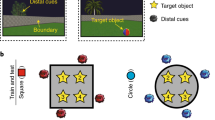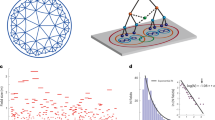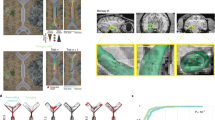Abstract
NEURONS sensitive to both place and direction from distinct regions of the hippocampal formation1–2, allometric relationships between spatial learning and hippocampal structure3,4 and pronounced impairments in spatial learning after lesions in this area5–8, indicate that the hippocampal formation subserves allocentric spatial learning9,10. To learn more about the process of spatial representation, we have developed a task that provides independent control of both landmark and directional cues. On the basis of physiological11 and behavioural12 work, this task also makes it possible to investigate the relevance of associative learning principles, such as predictability13, to the spatial domain. We report here that although rats learn to discriminate between landmarks on the basis of their proximity to a reliably predicted food reward, they will only learn to use them to represent its location if they maintain stable locations within a geometric frame of reference.
This is a preview of subscription content, access via your institution
Access options
Subscribe to this journal
Receive 51 print issues and online access
$199.00 per year
only $3.90 per issue
Buy this article
- Purchase on Springer Link
- Instant access to full article PDF
Prices may be subject to local taxes which are calculated during checkout
Similar content being viewed by others
References
O'Keefe, J. Expl Neurol 51, 78–109 (1976).
Taube, J. S., Muller, R. U. & Ranck, J. B. Jr J. Neurosci. 10, 420–435 (1990).
Krebs, J. R., Sherry, D. F., Healy, S. D., Perry, V. H. & Vaccarino, A. L. Proc. natn. Acad. Sci. U.S.A. 86, 1388–1392 (1989).
Lipp, H-P. & Schwegler, H. in The Hippocampus—New Vistas (eds Chan-Palay, V. & Kohler, C.) 395–410 (Liss, New York, 1989).
Smith, M. L. & Milner, B. Neuropsychologia 19, 781–793 (1991).
Morris, R. G. M., Garrud, P., Rawlins, J. N. P. & O'Keefe, J. Nature 297, 681–683 (1982).
Bingman, V. P., Ioale, P., Casini, G. & Bagnoli, P. Behav. Brain Res. 24, 147–156 (1987).
Parkinson, J. K., Murray, E. A. & Mishkin, M. J. Neurosci 8, 4159–4167 (1988).
O'Keefe, J. & Nadel, L. The Hippocampus as a Cognitive Map (Oxford Univ. Press, Oxford, 1978).
Worden, R. P. Hippocampus 2, 165–188 (1992).
O'Keefe, J. & Speakman, A. Expl Brain Res. 68, 1–27 (1987).
Collet, T. S., Cartwright, B. A. & Smith, B. A. J. comp. Physiol. A158, 835–851 (1986).
Mackintosh, N. J. Conditioning and Associative Learning (Oxford Univ. Press, Oxford, 1983).
Diez-Chamizo, V., Sterio, D. & Mackintosh, N. J. Q. Jl exp. Psychol. 37B, 235–253 (1985).
Reid, I. C. & Morris, R. G. M. Proc. R. Soc. B247, 137–143 (1992).
Sherry, D. F. & Schacter, D. L. Psychol. Rev. 94, 439–454 (1987).
Dickinson, A. & Mackintosh, N. J. A. Rev. Psychol 29, 587–612 (1978).
Brown, P. L. & Jenkins, H. M. J. exp. Anal. Behav. 11, 1–8 (1968).
Nadel, L. Hippocampus 1, 221–229 (1991).
Morris, R. G. M. Cold Spring Harb. Symp quant Biol. 55, 161–174 (1990).
Craik, K. The Nature of Explanation (Cambridge Univ. Press, Cambridge, 1943).
Johnson-Laird, P. N. Mental Models (Cambridge Univ. Press, Cambridge, 1983).
Author information
Authors and Affiliations
Rights and permissions
About this article
Cite this article
Biegler, R., Morris, R. Landmark stability is a prerequisite for spatial but not discrimination learning. Nature 361, 631–633 (1993). https://doi.org/10.1038/361631a0
Received:
Accepted:
Issue Date:
DOI: https://doi.org/10.1038/361631a0
This article is cited by
-
Object-vector coding in the medial entorhinal cortex
Nature (2019)
-
The cognitive map in humans: spatial navigation and beyond
Nature Neuroscience (2017)
-
Integration of objects and space in perception and memory
Nature Neuroscience (2017)
-
Effects of landmark distance and stability on accuracy of reward relocation
Animal Cognition (2015)
-
Changing within-trial array location and target object position enhances rats’ (Rattus norvegicus) missing object recognition accuracy
Animal Cognition (2012)
Comments
By submitting a comment you agree to abide by our Terms and Community Guidelines. If you find something abusive or that does not comply with our terms or guidelines please flag it as inappropriate.



